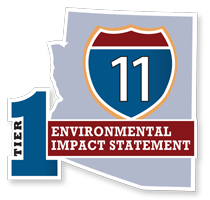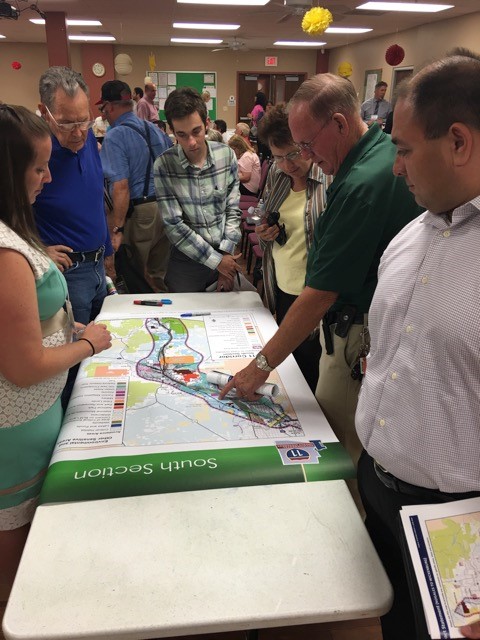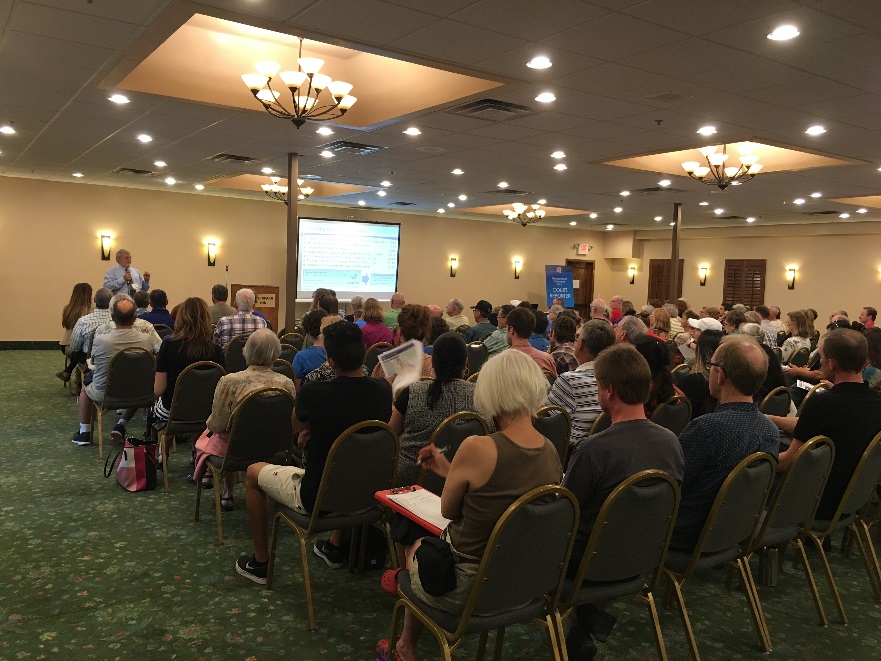 Interstate 11 Corridor Tier 1 Environmental Impact Statement, Nogales to Wickenburg
Interstate 11 Corridor Tier 1 Environmental Impact Statement, Nogales to Wickenburg


On July 16, 2021, the Arizona Department of Transportation, in conjunction with the Federal Highway Administration, released the Final Tier 1 EIS document for the Interstate 11 Corridor, Wickenburg to Nogales.
During the public review period, the Final Tier 1 EIS document was available online and at the locations listed below from July 16 to August 16, 2021.
On April 5, 2019, the Arizona Department of Transportation, in conjunction with the Federal Highway Administration, released the Draft Tier 1 Environmental Impact Statement and Preliminary Section 4(f) Evaluation (Draft Tier 1 EIS) for the I-11 Corridor, Nogales to Wickenburg.
During the public review and comment period from April 5, 2019 to July 8, 2019, six public hearings took place at the locations, dates, and times listed below. The same information was provided continuously at each public hearing.
The Draft Tier 1 EIS was available online, at the public hearings and at the locations listed below for public review and comment from April 5, 2019 through July 8, 2019.
Monday, 4/29/19 | 5–8 p.m.
Palo Verde Energy Education Center
600 N. Verrado Way (formerly Airport Road), Buckeye
Tuesday, 4/30/19 | 4–7 p.m.
Wickenburg Community Center
160 N Valentine Street, Wickenburg
Wednesday, 5/1/19 | 5–8 p.m.
Holiday Inn
777 N. Pinal Avenue, Casa Grande
Tuesday, 5/7/19 | 4–7 p.m.
Quality Hotel Americana
639 N. Grand Avenue, Nogales
Wednesday, 5/8/19 | 3–8 p.m.
Tucson Convention Center Ballrooms/Lobby
260 S. Church Avenue, Tucson
Saturday 5/11/19 | 11 a.m.–4 p.m.
Marana High School Cafeteria
12000 W. Emigh Road, Marana
Public Hearing Materials
The Draft Tier 1 EIS was available online, at the public hearings and at the locations listed below for public review and comment from, April 5, 2019, to July 8, 2019.
The main objective of community outreach and public involvement is to solicit input through an open and transparent process that includes the public, businesses, property owners, agencies, stakeholders, tribal governments and community groups within the study area. The process has been structured to involve people early and often, and to share information as it becomes available.

The public involvement and outreach process is designed to be personal, transparent, accessible and extensive. Because of the large size of the study area, it has been divided into three distinct sections: South, Central and North. Public hearings were held in 2019 in each section and public meetings were conducted in each of the three sections in 2016 and 2017. In addition, a variety of opportunities have been made available for the community to get involved and stay informed about the study including:
Study Updates and Mailing List
Short study updates are frequently posted to the website, under Good to Know page, to inform the public and stakeholders when new information is available and to provide additional information on study-specific elements. Those on the study mailing list will receive an email each time a new update is posted. Join the I-11 Tier 1 EIS Mailing List to receive email blasts.
Advertising
Advertisements are placed in regional newspapers and with radio stations to announce meetings and other important study information.
Website
The study website is used to disseminate information and provide a schedule of events. The site is presented in English, with the ability to translate information into other languages. The website is frequently updated to feature new information, technical documents and reports.

The website is updated with the intent of providing real-time study information.
Meetings
Corridor-wide public meetings have been conducted at major study milestones to cover specific topics and provide opportunities for the community to interact with the study team to discuss study issues and recommendations.
For information about the next corridor-wide meeting dates, times and locations, and to view information from previous meetings, visit Public Meetings and Outreach.
Federal, State, Regional, County, Local Agency and Tribal Interaction and Involvement
Under Section 6002 of the Safe, Accountable, Flexible, Efficient Transportation Equity Act: A Legacy for Users (SAFETEA-LU), agencies are responsible for identifying any issues of concern regarding potential environmental, social or economic impacts that could substantially delay or prevent an agency from granting a permit or other approval needed for the study. Section 6002 is intended to assure that agencies are fully engaged in the study and the decisions regarding the alternatives to be evaluated.
In addition to outreach to the general public, an extensive agency coordination process has been occurring simultaneously. More than 60 agencies are included in the stakeholder database, including elected officials, federal agencies, tribal governments, organizations, special interest groups and other interested parties. These stakeholders receive email updates regarding study progress, and they are invited to key meetings during the environmental review process.
In addition, under the National Environmental Policy Act, specific agencies are called upon to have a more involved role in the study process. Nine agencies have accepted the opportunity to participate as Cooperating Agencies, which represent those with jurisdiction over any environmental impact involved in the study. They are responsible for identifying impacts and important issues to be addressed in the Tier 1 EIS pertaining to the agency’s jurisdictional resource(s) and for reviewing all technical documents. Fifty-two agencies have accepted the opportunity to engage as Participating Agencies, which are federal, state, regional, county and local agencies, as well as tribal governments, that may have an interest in the I-11 Corridor. Participating Agencies provide input on the Purpose and Need, range of alternatives, methodologies and level of detail required to evaluate impacts relative to their respective jurisdictional resource(s).
The Alternatives Selection Report documents the analysis of the proposed corridor options. Through this analysis, a reasonable range of alternatives was identified to be carried forward into the Draft Tier 1 Environmental Impact Statement for further study.
The 2017 Agency and Public Information Meeting Summary Report documents the feedback received through the various outreach mechanisms on the alternatives screening process and the proposed reasonable alternatives.
The Arizona Department of Transportation and the Federal Highway Administration held six public information meetings in 2017 to review and collect input on the proposed alternatives. The meetings were held throughout the corridor study area: Wickenburg, Buckeye, Casa Grande, Marana, Tucson and Nogales. The meetings provided an update on the study and sought input on the alternatives screening process and the recommended range of reasonable alternatives that could be advanced into the Draft Tier 1 Environmental Impact Statement for further study. The alternatives evaluation public meeting materials are provided below. Select the thumbnails to view the presentation, fact sheet and display boards from the alternatives evaluation public meetings.
Public Scoping is a time at the beginning of the Tier I EIS for the study team to learn from the community. As part of the scoping process, a series of public meetings were held throughout the Corridor Study Area, including Wickenburg, Buckeye, Casa Grande, Marana, Tucson and Nogales. The public scoping meetings provided study information, obtained community feedback on issues in the Corridor Study Area, and solicited input to form potential corridor alternatives.
A summary of the scoping process and feedback received through the various outreach mechanisms has been documented in a Scoping Summary Report.
The Arizona Department of Transportation (ADOT) and the Federal Highway Administration (FHWA) held six public scoping meeting as part of the environmental study for Interstate 11 (I-11) between Nogales and Wickenburg.
Public Scoping is a time at the beginning of the environmental study for the study team to learn from the community. As part of the scoping process, a series of public meetings were held throughout the Corridor Study Area, including Wickenburg, Buckeye, Casa Grande, Marana, Tucson and Nogales. The public scoping meetings provided study information, obtained community feedback on issues in the Corridor Study Area, and solicited input to form potential corridor alternatives. This public input will help ADOT and FHWA identify the selected corridor alternative and type of transportation facility.
The following list outlines the public meetings were held during the scoping period. Each meeting was held from 4-6:30 PM, with a presentation at approximately 4:15. The same information was presented at each meeting. Following the presentation, the meeting will be held in an open house format with study team members available to answer questions.
Select the thumbnails to view the presentation and boards from the public scoping meetings.